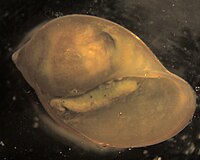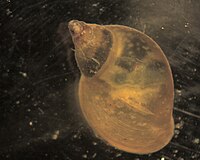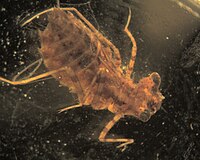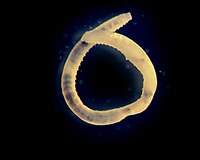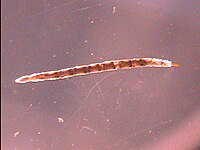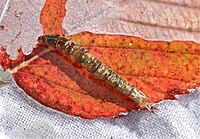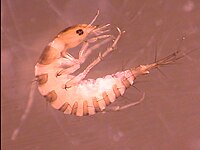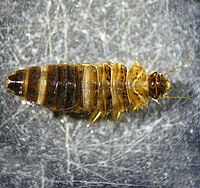Ethan Allen Homestead Roadside Pond
From WikiEducator
| Basin: | Winooski |
| State or Province: | Vermont |
| Country: | USA |
| Latitude: | 44.505877 |
| Longitude: | -73.233019 |
| School: | Hunt Middle School |
This page includes macroinvertebrates collected from the pond just west of the bikepath bridge at the Ethan Allen Homestead. The site is based upon samples taken by the dedicated students from Hunt Middle School grades 7 and 8. Nice work scientists!!
Contents
Chironomidae
Midge larvae tend to be the most common macroinvertebrate at our sites. As with other Diptera, there are no true jointed legs. Chironomidae do have a pair of prolegs at each end and preserved individuals tend to curl into a 'C'. Identification past family requires slide-mounted heads. We have seen philopotamid caddisflies misidentified with the chironomids and we suspect that that happens when samples are being sorted from trays. Under a microscope, six prominent legs can be seen on members of the caddisfly family Philopotamidae.
More information on Philopotamidae.
Physidae
Members of the family Physidae belong in the class of Gastropoda. Members contain a single, coiled shell with a left handed spiral going counterclockwise. Belonging to the family of aquatic pulmonates, members breathe air using a structure similar to a lung.
Images of the family Physidae, the class of Gastropodaand a shell with a left-handed spiral.
Lymnaeidae
Members of the family Lymnaeidae belong in the class of Gastropoda. Members contain a single, coiled shell with a right-handed spiral. Differing from those of Planorbidae, members of Lymnaeidae have a larger opening. Respiration in these snails are through lung-like structures. Preferred habitats include those with slow streaming waters and heavy vegetation. These right handed snails are somewhat less tolerant of water pollution than our other common snails.
Images of the family Lymnaeidae and the class Gastropoda.
Pisidiidae
Fingernail clams are the most common small clams that we find in Vermont rivers. Larger bivalves should not be sampled because they may belong to a protected species. Under no circumstances should clams be moved from one river site to another.
Libellulidae
These dragonfly larvae (sub-order Anisoptera) can be distinguished from damselfly larvae (sub-order Zygoptera) by their more robust bodies and an abdomen that ends in five 'spikes' as opposed to three gills. The family Libellulidae is characterized by their spoon-shaped mouthparts.They are distinguished from the other family with this trait, Cordulegastridae, by the small rounded teeth on the edges of their palpal lobes.
Images of the spoon-shaped mouthparts, and the small, rounded teeth.
Oligochaeta
Aquatic earthworms lack legs and are characterized by having 20 or more segments. Unlike leeches, they lack a suction disk. We collect members of two or more orders in this class as small numbers of stream sites and they are rarely numerous. They are more common at pond and lake sites.
Image of the 20 or more segments.
Ceratopogonidae
Members of this family look like very straight Chironomidae. They are very long and thin with a distinct head capsule and no prolegs. Some in the lab call them 'bamboo sticks' with eyes.
Image of the distinct head capsule.
Hexatoma
This Tipulidae can be identified by the swollen 7th abdominal segment. The swelling is bulbous and frequently as much as 2X abdominal diameter in preserved specimens.
Dytiscus
Adult Dytiscidae have streamlined bodies and hind-legs modified for swimming. They are characterized by the division of the first abdominal segment by the hind coxae. Don't let the paired claws and prominent 'tails' of Dytiscus larva tempt you to think 'stonefly'; these tails are far less segmented than Plecoptera tails.The head and jaws are also unlike those of stoneflies.
Images of the hind-legs, first abdominal segment, 'tails', Plecoptera tails, and the head and jaws.
Scirtidae
As their common name suggests, marsh beetles are found among vegetation in aquatic habitats. They have a distinctive shape and the photograph should help with identification.


